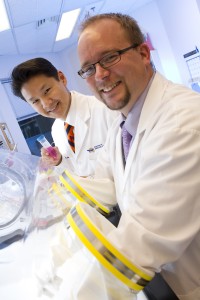Urinary stone disease has been in existence for 7,000 years and currently affects up to 10% of the population. It constitutes a major health care burden, causing significant pain and suffering in those afflicted and results in billions of dollars in lost wages and medical costs. Millions of people suffer from the disease in Canada alone. Our research aims to help improve the healthcare of many Canadians and also advance our knowledge of urology and particularly kidney stone disease.
The Stone Centre has a unique advantage due to partnerships of basic science, clinical, and translational research. We have over 30 projects in clinical and combined clinical and laboratory settings, and over 10 projects in the laboratory setting only, ongoing simultaneously. In addition, we collaborate on research projects with various sites across Canada, United States, Japan, China, South America, and Europe, to ensure consistency and delivery of best treatment and care for our patients.
The main aspects of our research work are outlined below:
 Oxalate and gut bacteria research. The most common and clinically relevant stones are those composed of calcium oxalate (CaOx), comprising greater than 80% of all urinary tract calculi, but other less predominant stones that occur in the population include, calcium phosphate, uric acid, struvite (infectious), cystine (genetically linked) and so on.
Oxalate and gut bacteria research. The most common and clinically relevant stones are those composed of calcium oxalate (CaOx), comprising greater than 80% of all urinary tract calculi, but other less predominant stones that occur in the population include, calcium phosphate, uric acid, struvite (infectious), cystine (genetically linked) and so on.
In addition to their high frequency, CaOx calculi also have a high degree of recurrence, with rates of 10% at 1 year, 35% at 5 years and 50% at 10 years. Patients with a greater than normal amount of oxalate excreted in the urine (hyperoxaluria) are at significantly increased risk for initial development and subsequent recurrence of stones. Approximately 24-32% of patients with stones have hyperoxaluria, a condition that can occur via several mechanisms, such as an increase in oxalate production by the liver, or increases in dietary intake or intestinal absorption of oxalate. Up to 80% of the oxalate filtered into the urine by the kidney originates from dietary sources. Currently, medical interventions for the prevention and treatment of hyperoxaluria are limited and consist mainly of reducing dietary oxalate and sodium or adding supplemental calcium, as well as increasing daily fluid intake. Although these dietary alterations can lower urinary levels in some patients, they are not universally successful. Clearly, novel therapies in calcium oxalate stone prevention and treatment are warranted.
Our laboratory research is aimed at utilizing the mechanisms of oxalate transport in the gastrointestinal (GI) tract to prevent oxalate absorbtion and accumulation in the kidneys. The association between the presence of oxalate-degrading bacteria in the intestinal tract and a reduced risk of calcium oxalate stone formation may be exploited as a potential therapy for preventing stone recurrences. With that in mind we are studying commensal bacteria such as Oxalobacter formigenes in terms of its ability to degrade oxalate in the small intestine and persist in the human host.
Medical Devices for use in the Urinary System. The other area of research in the lab is in the area of biomaterials as they pertain to urinary devices. We are investigating new coatings and special drug-eluting materials for urinary catheters and stents in an attempt to make them more biocompatible and reduce device-related infection, encrustation, and patient discomfort.
Identification of Levels of Urinary Compounds. Patients who continue to form stones will have a test done where they collect their urine for an entire 24 hours to determine how their body handles certain minerals and electrolytes. By doing this, high levels of calcium, oxalate, sodium, or other minerals that put one at risk for forming kidney stones can be identified. Patients can then be counseled to alter their diet to avoid certain foods, or eat more of certain types. Sometimes, medications are prescribed in an attempt to lower urinary levels of certain minerals.
The 24 hour collection means that patients must collect EVERY bit of urine over the entire day. This can be cumbersome and difficult for patients to do. Furthermore, we hypothesize that there may spikes in levels of certain compounds throughout the day that are missed by this 24 hour collection. For instance, there may be a spike in urinary calcium levels after lunch that may increase one’s risk for forming stones, but this would not show up as abnormal on a 24 hour collection because the urine from the rest of the day would dilute this spike and make it seem “normal”.
We are performing a study to look at the urine of stone forming patients over certain periods of the day to see if we can identify a better time period to collect urine. This would do two things: 1. It would make it easier for patients to collect urine (e.g. 4-6 hours rather than 24 hours) and 2. It may identify certain abnormalities that would not be picked up on the standard 24 hour urine exam.
New Devices to Break Kidney Stones. The investigators at the Stone Centre are on the cutting edge of technology and are involved with several trials involving centres around North America evaluating how new devices can fragment kidney stones. New devices and methods of breaking up kidney stones during surgery have been evaluated and this is important work that will help future stone patients and the doctors who treat them.
Other research includes, investigating causes of kidney stones and the link between urinary components and kidney stone formation, infection in stones, antibiotic treatment post kidney stones removal procedures, and more.
